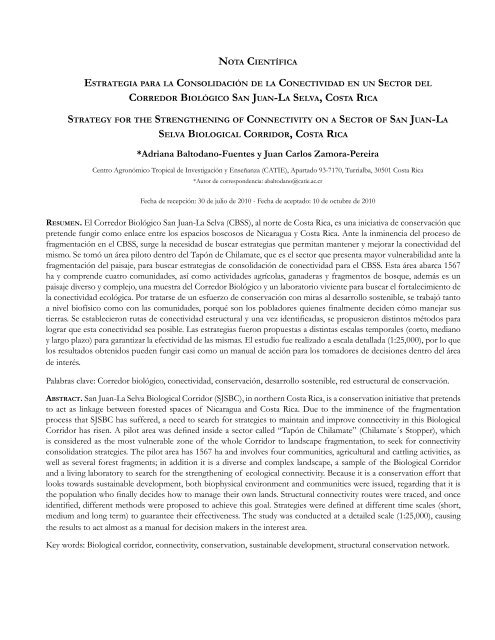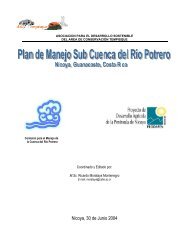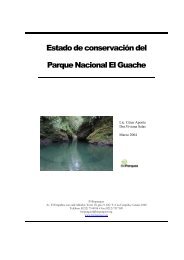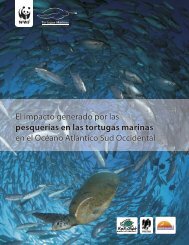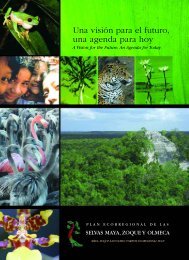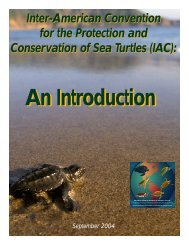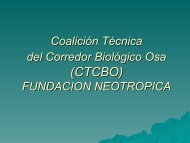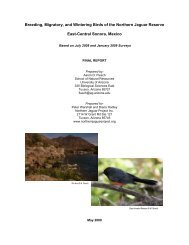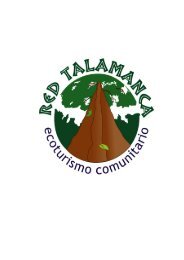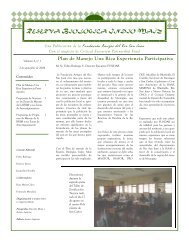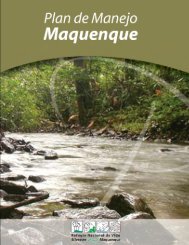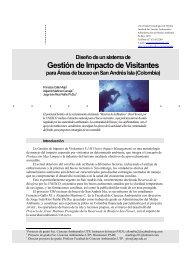Volumen 14(3) Noviembre de 2010 - Eco-Index
Volumen 14(3) Noviembre de 2010 - Eco-Index
Volumen 14(3) Noviembre de 2010 - Eco-Index
Create successful ePaper yourself
Turn your PDF publications into a flip-book with our unique Google optimized e-Paper software.
No ta CientíficaEs t r a t e g i a pa r a l a Co n s o l i d a c i ó n d e l a Conectividad e n u n Se c t o r d e lCo r r e d o r Bi o l ó g i c o Sa n Jua n -La Se l va, Co s ta Ri c aSt r a t e g y f o r t h e St r e n g t h e n i n g o f Co n n e c t i v i t y o n a Se c t o r o f Sa n Jua n -LaSe l va Bi o l o g i c a l Co r r i d o r, Co s ta Ri c a*Adriana Baltodano-Fuentes y Juan Carlos Zamora-PereiraCentro Agronómico Tropical <strong>de</strong> Investigación y Enseñanza (CATIE), Apartado 93-7170, Turrialba, 30501 Costa Rica*Autor <strong>de</strong> correspon<strong>de</strong>ncia: abaltodano@catie.ac.crFecha <strong>de</strong> recepción: 30 <strong>de</strong> julio <strong>de</strong> <strong>2010</strong> - Fecha <strong>de</strong> aceptado: 10 <strong>de</strong> octubre <strong>de</strong> <strong>2010</strong>Re s u m e n. El Corredor Biológico San Juan-La Selva (CBSS), al norte <strong>de</strong> Costa Rica, es una iniciativa <strong>de</strong> conservación quepreten<strong>de</strong> fungir como enlace entre los espacios boscosos <strong>de</strong> Nicaragua y Costa Rica. Ante la inminencia <strong>de</strong>l proceso <strong>de</strong>fragmentación en el CBSS, surge la necesidad <strong>de</strong> buscar estrategias que permitan mantener y mejorar la conectividad <strong>de</strong>lmismo. Se tomó un área piloto <strong>de</strong>ntro <strong>de</strong>l Tapón <strong>de</strong> Chilamate, que es el sector que presenta mayor vulnerabilidad ante lafragmentación <strong>de</strong>l paisaje, para buscar estrategias <strong>de</strong> consolidación <strong>de</strong> conectividad para el CBSS. Esta área abarca 1567ha y compren<strong>de</strong> cuatro comunida<strong>de</strong>s, así como activida<strong>de</strong>s agrícolas, gana<strong>de</strong>ras y fragmentos <strong>de</strong> bosque, a<strong>de</strong>más es unpaisaje diverso y complejo, una muestra <strong>de</strong>l Corredor Biológico y un laboratorio viviente para buscar el fortalecimiento <strong>de</strong>la conectividad ecológica. Por tratarse <strong>de</strong> un esfuerzo <strong>de</strong> conservación con miras al <strong>de</strong>sarrollo sostenible, se trabajó tantoa nivel biofísico como con las comunida<strong>de</strong>s, porqué son los pobladores quienes finalmente <strong>de</strong>ci<strong>de</strong>n cómo manejar sustierras. Se establecieron rutas <strong>de</strong> conectividad estructural y una vez i<strong>de</strong>ntificadas, se propusieron distintos métodos paralograr que esta conectividad sea posible. Las estrategias fueron propuestas a distintas escalas temporales (corto, medianoy largo plazo) para garantizar la efectividad <strong>de</strong> las mismas. El estudio fue realizado a escala <strong>de</strong>tallada (1:25,000), por lo quelos resultados obtenidos pue<strong>de</strong>n fungir casi como un manual <strong>de</strong> acción para los tomadores <strong>de</strong> <strong>de</strong>cisiones <strong>de</strong>ntro <strong>de</strong>l área<strong>de</strong> interés.Palabras clave: Corredor biológico, conectividad, conservación, <strong>de</strong>sarrollo sostenible, red estructural <strong>de</strong> conservación.Ab s t r a c t. San Juan-La Selva Biological Corridor (SJSBC), in northern Costa Rica, is a conservation initiative that pretendsto act as linkage between forested spaces of Nicaragua and Costa Rica. Due to the imminence of the fragmentationprocess that SJSBC has suffered, a need to search for strategies to maintain and improve connectivity in this BiologicalCorridor has risen. A pilot area was <strong>de</strong>fined insi<strong>de</strong> a sector called “Tapón <strong>de</strong> Chilamate” (Chilamate´s Stopper), whichis consi<strong>de</strong>red as the most vulnerable zone of the whole Corridor to landscape fragmentation, to seek for connectivityconsolidation strategies. The pilot area has 1567 ha and involves four communities, agricultural and cattling activities, aswell as several forest fragments; in addition it is a diverse and complex landscape, a sample of the Biological Corridorand a living laboratory to search for the strengthening of ecological connectivity. Because it is a conservation effort thatlooks towards sustainable <strong>de</strong>velopment, both biophysical environment and communities were issued, regarding that it isthe population who finally <strong>de</strong>ci<strong>de</strong>s how to manage their own lands. Structural connectivity routes were traced, and oncei<strong>de</strong>ntified, different methods were proposed to achieve this goal. Strategies were <strong>de</strong>fined at different time scales (short,medium and long term) to guarantee their effectiveness. The study was conducted at a <strong>de</strong>tailed scale (1:25,000), causingthe results to act almost as a manual for <strong>de</strong>cision makers in the interest area.Key words: Biological corridor, connectivity, conservation, sustainable <strong>de</strong>velopment, structural conservation network.


